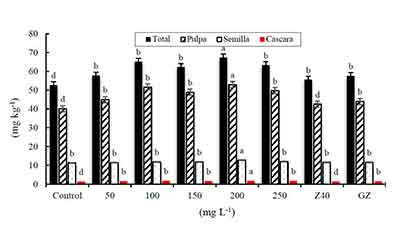Zinc oxide nanoparticles and their effect on melon yield and quality
DOI:
https://doi.org/10.29312/remexca.v12i5.2987Keywords:
Cucumis melo L., DPPH, flavonoids, nanoparticles, phenolsAbstract
The research consisted of the foliar application of zinc oxide nanoparticles (NPs ZnO), two commercial sources (Z40 and GZ), in addition to a control treatment and their effect on yield and commercial and nutraceutical quality in cv Cruiser melon fruits (Cucumis melo L.). The treatments consisted of the foliar application of five doses of NPs ZnO: 50, 100, 150, 200 and 250 mg L-1. The results indicated that the highest yield was for the treatment with 200 mg L-1 of NPs ZnO, with an increase of 53 t ha-1 in relation to the control, the same trend was for the weight of the fruit that showed values of 1.74 kg, 1.45 kg and 1.33 kg, respectively. Concerning flavonoid content, doses of 50 and 100 mg L-1 exceeded the control treatment and commercial sources; however, as the concentration of NP increased, flavonoids decreased. Phenols, antioxidant capacity (DPPH) and vitamin C decreased by 17, 10. 8 and 9% with the control, respectively. The highest concentration of zinc in pulp was observed with 200 mg L-1 of NPs ZnO. The use of zinc nanoparticles is a good alternative to improve the yield and nutraceutical content and the concentration of Zn in melon fruits, being an option to combat the malnutrition of this micronutrient.
Downloads

Downloads
Published
How to Cite
Issue
Section
License
Copyright (c) 2021 Revista Mexicana de Ciencias Agrícolas

This work is licensed under a Creative Commons Attribution-NonCommercial 4.0 International License.
The authors who publish in Revista Mexicana de Ciencias Agrícolas accept the following conditions:
In accordance with copyright laws, Revista Mexicana de Ciencias Agrícolas recognizes and respects the authors’ moral right and ownership of property rights which will be transferred to the journal for dissemination in open access. Invariably, all the authors have to sign a letter of transfer of property rights and of originality of the article to Instituto Nacional de Investigaciones Forestales, Agrícolas y Pecuarias (INIFAP) [National Institute of Forestry, Agricultural and Livestock Research]. The author(s) must pay a fee for the reception of articles before proceeding to editorial review.
All the texts published by Revista Mexicana de Ciencias Agrícolas —with no exception— are distributed under a Creative Commons License Attribution-NonCommercial 4.0 International (CC BY-NC 4.0), which allows third parties to use the publication as long as the work’s authorship and its first publication in this journal are mentioned.
The author(s) can enter into independent and additional contractual agreements for the nonexclusive distribution of the version of the article published in Revista Mexicana de Ciencias Agrícolas (for example include it into an institutional repository or publish it in a book) as long as it is clearly and explicitly indicated that the work was published for the first time in Revista Mexicana de Ciencias Agrícolas.
For all the above, the authors shall send the Letter-transfer of Property Rights for the first publication duly filled in and signed by the author(s). This form must be sent as a PDF file to: revista_atm@yahoo.com.mx; cienciasagricola@inifap.gob.mx; remexca2017@gmail.
This work is licensed under a Creative Commons Attribution-Noncommercial 4.0 International license.


